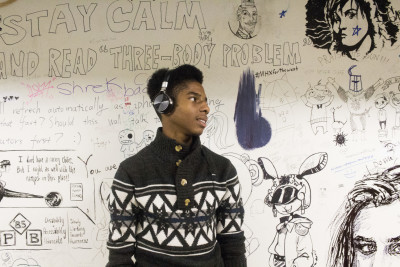An Era of Rap
BY MARIELLE MANGANAAN

Delroy Gordon, 19, in his second year of Visual Creative Arts shares his favour for the direction hip-hop culture has taken in the last decade.
Rap music has come a long way to be dominating in the music industry today. In over a decade, it has risen through years of ridicule and controversy to now stand at the forefront of pop culture in fashion, social media, and sports.
With its hard-hitting beats and lyrics that confront sensitive personal and social topics, icons in the industry and their influence on the audience induced a movement toward equality and broke down censorship. It is a large factor in what we see today; a generation of millennials who actively participate in the art of expression and equality every day.
Juno-Nominated recording artist and professor at Sheridan College for Bachelor of Music Theatre, Mary-Lu Zahalan, said, “it was unlike anything we were hearing at the time. It felt rebellious and dangerous.”
Zahalan remembers some of the context to be sexualized and offensive, but the fan base was “solid and fierce in defending its rightful place in the music industry.”
“It broke down some cultural and racial boundaries. It was accessible to a large population and it didn’t take a ton of musical production to have an impact.
Zahalan likens the socially conscious nature of rap with the free styling protest poetry of the ‘60s where icons such as Bob Dylan and Paul Simon promoted ‘love and peace’, a key factor being that it seemed to come from a predominantly white, educated audience, while rap seemed to promote ‘violence & hate’, which had come from a predominantly black, less fortunate background.
In the nineties, when rap first broke out as its own genre, there was only negative feedback. People weren’t used to it and felt uncomfortable with its daring nature, both lyrically and sonically.
Rap groups such as N.W.A., Public Enemy, and Wu-Tang Clan boldly put out content that spoke against discrimination, their experiences under police brutality, and the struggles of living in poverty, as well as drugs and gang violence in the community.
People generally interpreted their craft as a glamorization of a lifestyle of violence. And although similar themes are sometimes echoed in the music today, listeners have shifted in the way they interpret it, understanding that it’s simply a story being told of struggle and perseverance.
“The paradigm shift in rap music today came from an accumulation of a cry for help all those years. I think rap always represented those oppressed and spoke for the people,” said Delroy Gordon, 19, a second year Visual Creative Arts student at Sheridan.
Gordon debunks the notion that rap endorses violence.
“That’s wrong. There are a billion artists who rap about positive subjects. Some do talk about violence, but that doesn’t define their single art form.”
The negative connotations posed on the genre would eventually be dismantled, as rap music outgrew its niche of a “gangsta” lifestyle theme, and into more socially conscious and thought-provoking content.
“I think once we started hearing different subject matter from icons like Tupac and those guys, once we started hearing intelligent conversations from them it kind of spun the whole genre to a different direction.” said Gordon.
The young fan base grew rapidly over the years from because of being able to relate to the thought processes and emotions rappers exposed in their storytelling. The diversity of the stories expanded, and whether or not the artist came from harder backstories, they had something to say and people listened.
Judd Orcasitas, 20, a second-year Communications Culture Information Technology student believes “people were able to connect to the words more than the sound itself.”
“It became popular because people wanted to hear something different, there was nothing like that at the time it started. You’re just able to say whatever you want, it’s cohesive.” said Orcasitas.
When artists like Nas, Eminem, Lupe Fiasco, and Kanye West broke out rapping about every day life, personal growth and struggles, it became evident that taking part in the hip hop culture or its music no longer required a history that involved drugs, guns, and poverty.
Macklemore, Iggy Azeala, Nicki Minaj, Frank Ocean, Drake, and Kendrick Lamar are the rappers to the millennials who have all produced worldwide hits with diversified content that connects to all the types of social norms existing today – the byproduct of years of fighting censorship and inequality.
Zahalan says that the genre’s “part in our musical evolution was essential to what we call mainstream pop today. It has become integrated in every genre of music now and some would argue that Rap is the new Pop of this generation.”
“Artists from Tupac Shakur to Wiz Khalifa, Common were and are brilliant wordsmiths; Kanye is equal parts brilliant and repulsive and like it or not, rap music is an essential element of popular music today.
“And it doesn’t even matter if you’re black or white anymore,” said Gordon.
“If you’re feeling like you’re fighting a battle you can’t win, that’s the music that speaks for you. That’s why I connect to it, and why others have all these years.”
Added by marielle on December 2, 2015.
Saved under Arts, Features, Music, Opinion
Tags: art, Arts, College, culture, era of rap, hip hop music, hiphop, Music, Opinion, rap, rap music, Sheridan, Sheridan College, teaser